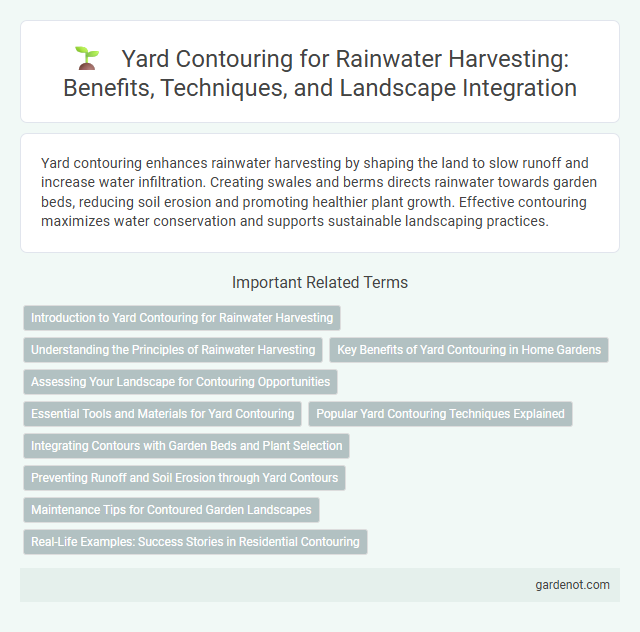Yard contouring enhances rainwater harvesting by shaping the land to slow runoff and increase water infiltration. Creating swales and berms directs rainwater towards garden beds, reducing soil erosion and promoting healthier plant growth. Effective contouring maximizes water conservation and supports sustainable landscaping practices.
Introduction to Yard Contouring for Rainwater Harvesting
Yard contouring is a strategic landscaping technique designed to capture and direct rainwater efficiently, reducing runoff and promoting groundwater recharge. By shaping the terrain into gentle slopes and swales, yard contouring maximizes water infiltration and supports soil moisture retention. This method enhances sustainability in residential and urban environments by optimizing natural rainwater flow for irrigation and reducing erosion.
Understanding the Principles of Rainwater Harvesting
Yard contouring involves shaping the land to create gentle slopes and terraces, which slow down rainwater runoff and encourage infiltration into the soil. This method aligns with rainwater harvesting principles by maximizing water capture and reducing erosion while promoting groundwater recharge. Effective contouring integrates vegetation placement to stabilize soil and enhance water retention, supporting sustainable yard irrigation and conservation.
Key Benefits of Yard Contouring in Home Gardens
Yard contouring enhances rainwater harvesting by directing runoff toward garden beds, improving soil moisture retention and reducing erosion. This technique promotes healthier plant growth and decreases the need for supplemental irrigation, resulting in water conservation. Effective yard contouring also minimizes nutrient loss and helps maintain a sustainable garden ecosystem.
Assessing Your Landscape for Contouring Opportunities
Evaluating your landscape for yard contouring opportunities involves identifying natural slopes, drainage patterns, and low-lying areas that can be reshaped to optimize rainwater capture. Analyzing soil type, vegetation cover, and existing runoff flow helps determine the best contour lines for directing water toward rain gardens or storage areas. Proper assessment ensures effective water retention, reduces erosion, and enhances groundwater recharge in rainwater harvesting systems.
Essential Tools and Materials for Yard Contouring
Essential tools for yard contouring in rainwater harvesting include shovels, rakes, and hoes designed for soil manipulation and grading. Materials such as landscape fabric, mulch, and erosion control blankets help stabilize the soil and prevent runoff. Heavy equipment like mini-excavators or skid-steer loaders may be necessary for larger-scale contouring projects to efficiently shape the terrain and direct water flow.
Popular Yard Contouring Techniques Explained
Popular yard contouring techniques for rainwater harvesting include swales, berms, and terraces, which help direct and capture runoff effectively. Swales are shallow, broad channels designed to slow water flow and increase infiltration, while berms serve as raised barriers to redirect water. Terracing involves creating stepped levels on slopes to reduce erosion and promote water retention for lawn and garden irrigation.
Integrating Contours with Garden Beds and Plant Selection
Yard contouring enhances rainwater harvesting by directing runoff toward garden beds, maximizing water absorption and reducing erosion. Integrating contours with carefully selected drought-tolerant and native plants improves soil retention and optimizes water use efficiency. Strategic placement of garden beds along contours ensures that rainwater infiltrates the soil, supporting healthy plant growth and sustainable landscape management.
Preventing Runoff and Soil Erosion through Yard Contours
Yard contouring shapes the landscape to slow water flow, effectively reducing runoff and preserving fertile topsoil. By creating gentle slopes and berms aligned with natural land gradients, yard contours capture and direct rainwater into the soil, promoting groundwater recharge. This technique minimizes soil erosion, preventing nutrient loss and maintaining soil structure essential for healthy vegetation and sustainable rainwater harvesting.
Maintenance Tips for Contoured Garden Landscapes
Regularly inspect contour berms and swales to prevent erosion and sediment buildup, ensuring optimal water flow and retention in your yard. Remove debris and repair any damaged areas promptly to maintain the structural integrity of contoured garden landscapes. Mulching around plants helps retain moisture and suppress weeds, promoting a healthy and sustainable rainwater harvesting system.
Real-Life Examples: Success Stories in Residential Contouring
Yard contouring for rainwater harvesting has transformed residential landscapes, exemplified by a California homeowner who reduced runoff by 60% through strategic berms and swales. In Texas, contouring slopes in suburban yards directed water to native plant gardens, significantly improving groundwater recharge and reducing irrigation needs. These success stories highlight how precise land shaping supports sustainable water management and enhances local ecosystems.
Yard contouring Infographic

 gardenot.com
gardenot.com